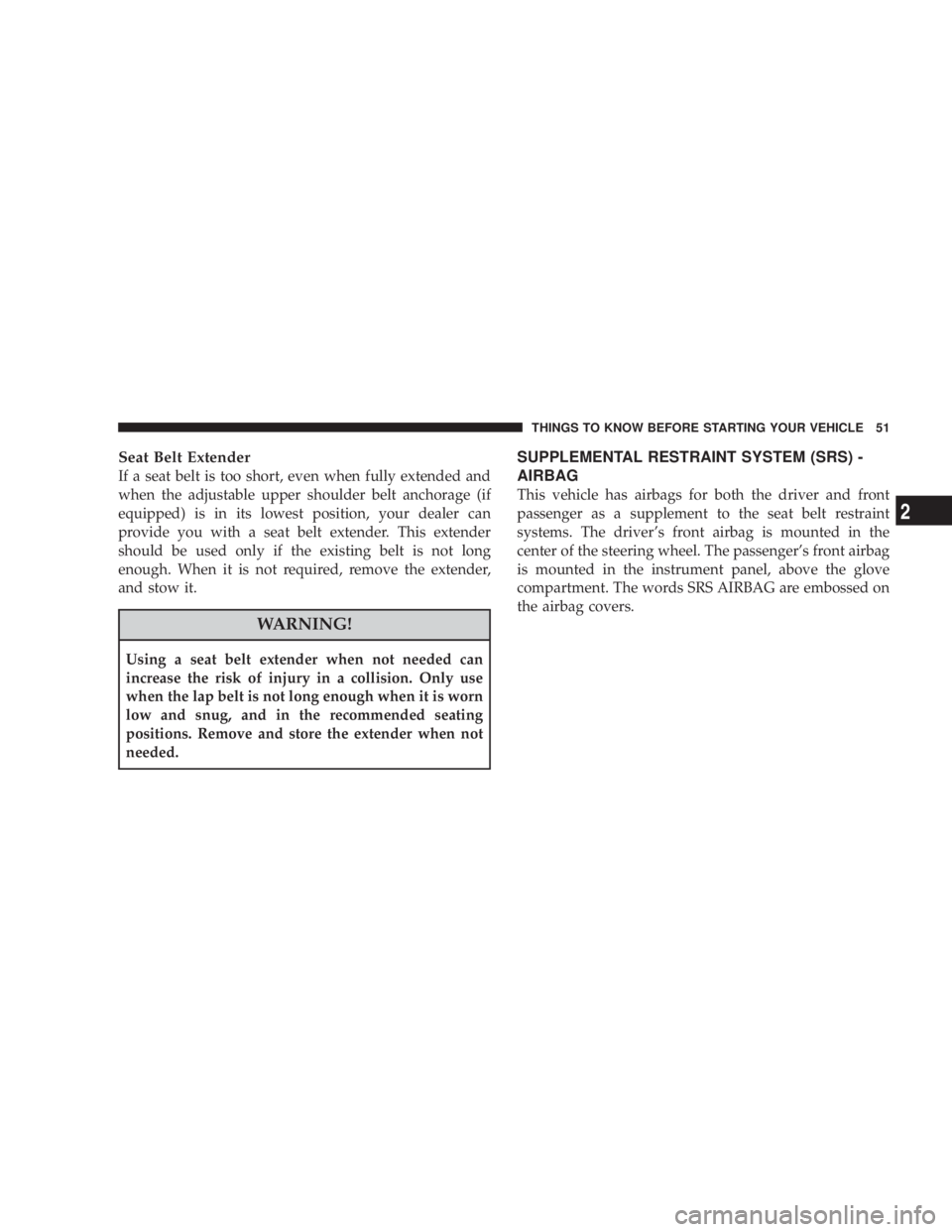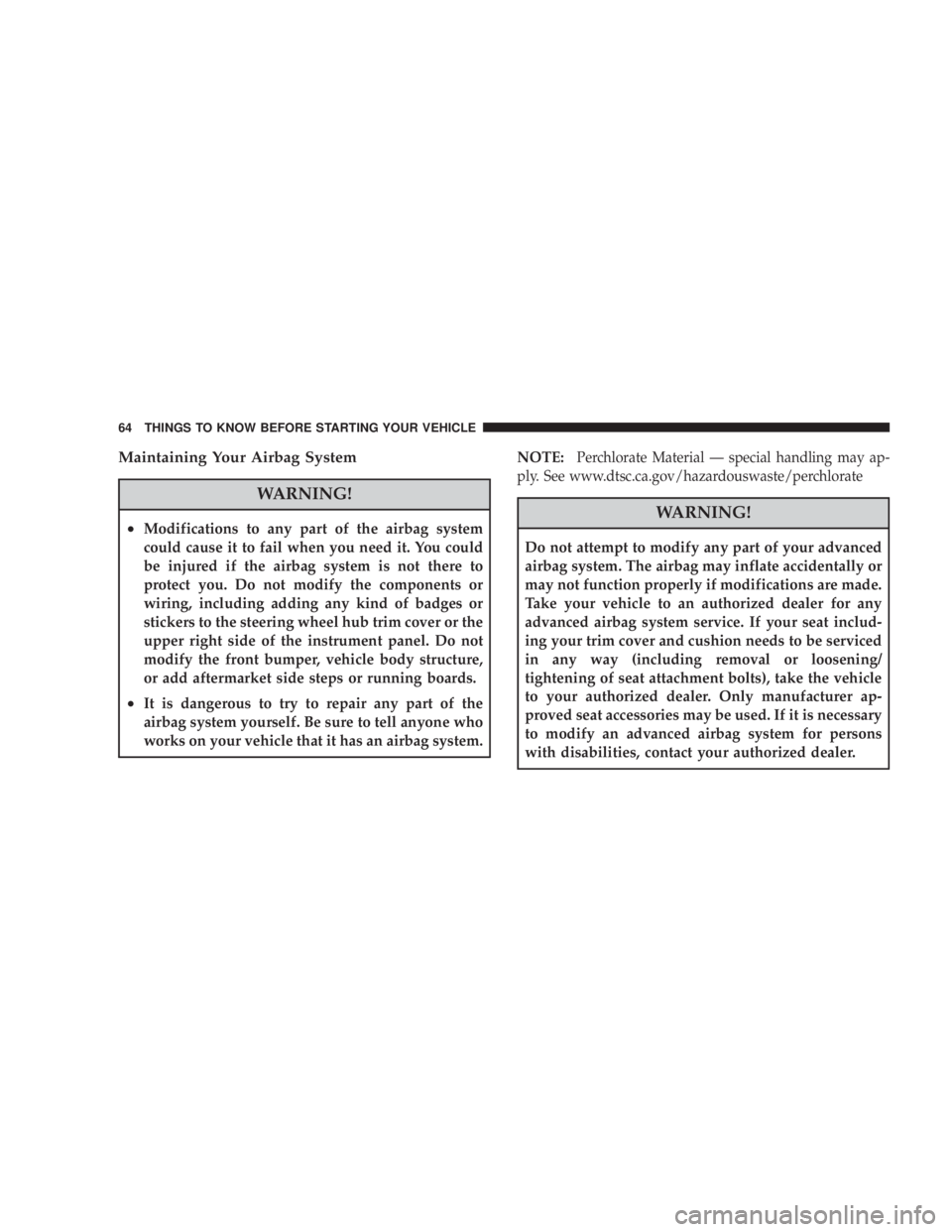instrument panel DODGE AVENGER 2008 Owners Manual
[x] Cancel search | Manufacturer: DODGE, Model Year: 2008, Model line: AVENGER, Model: DODGE AVENGER 2008Pages: 467, PDF Size: 7.16 MB
Page 3 of 467

TABLE OF CONTENTSSECTION PAGE
1
INTRODUCTION
.............................................................32
THINGS TO KNOW BEFORE STARTING YOUR VEHICLE
...............................93
UNDERSTANDING THE FEATURES OF YOUR VEHICLE
...............................814
UNDERSTANDING YOUR INSTRUMENT PANEL
................................... 1635
STARTING AND OPERATING
................................................. 2576
WHAT TO DO IN EMERGENCIES
...............................................3477
MAINTAINING YOUR VEHICLE
............................................... 3658
MAINTENANCE SCHEDULES
.................................................. 4259
IF YOU NEED CONSUMER ASSISTANCE
..........................................43310
INDEX
....................................................................443 1
2
3
4
5
6
7
8
9
10
Page 8 of 467

WARNINGS AND CAUTIONS
This manual contains WARNINGS against operating
procedures that could result in an accident or bodily
injury. It also contains CAUTIONS against procedures
that could result in damage to your vehicle. If you do not
read this entire manual you may miss important infor-
mation. Observe all Warnings and Cautions.
VEHICLE IDENTIFICATION NUMBER
The Vehicle Identification Number (VIN) is found on the
left front corner of the instrument panel, visible through
the windshield. This number also appears on the vehicle
registration and title. Vehicle Identification Number6 INTRODUCTION
Page 21 of 467

will automatically disarm. After 16 seconds, the Vehicle
Security Light will flash slowly. This shows that the
system is fully armed.
NOTE:
² During the 16 second arming period, if a door is
opened or the ignition switch is turned ON, the system
will automatically disarm.
² Once armed, the system disables the unlock switch on
the driver door trim panel and passenger door trim
panel, the trunk release button on the instrument
panel, and the HomeLink t /Garage Door Opener (if
equipped).
TO DISARM THE SYSTEM
Either press the UNLOCK button on the remote keyless
entry transmitter or insert a valid sentry key into the
ignition lock cylinder and turn the key to the ON/START
position. NOTE:
² The driver's door key cylinder and the trunk button on
the keyless entry transmitter cannot arm or disarm the
system.
² The system remains armed during trunk entry. Press-
ing the trunk button will not disarm the system. If
someone enters the vehicle through the trunk and
opens any door, the alarm will sound.
² When the system is armed, the interior power door
lock switches will not unlock the doors.
The Vehicle Security Alarm system is designed to protect
your vehicle; however, you can create conditions where
the system will give you a false alarm. If one of the
previously described arming sequences has occurred, the
system will arm regardless of whether you are in the
vehicle or not. If you remain in the vehicle and open a
door, the alarm will sound. If this occurs, disarm the
system. THINGS TO KNOW BEFORE STARTING YOUR VEHICLE 19
2
Page 41 of 467

TRUNK RELEASE
From inside the car the trunk lid
can be released by depressing the
Trunk Release Button located on
the instrument panel to the left of
the steering wheel. The transmis-
sion must be in Park before the
switch will operate.
NOTE: The gear selector lever must be in PARK for this
switch to operate.
To unlatch the trunk lid from outside the vehicle, press
and release the TRUNK button on the Remote Keyless
Entry (RKE) transmitter two times.
With the ignition ON, the word ªdeckº will display in
place of the odometer display indicating that the trunk is
open. The odometer display will reappear once the trunk
is closed or if the trip button is depressed. With the key in the lock position or with the key out, the
word ªdeckº will display until the trunk is closed.
On EVIC equipped vehicles, the words ªTrunk Ajarº will
display.
TRUNK SAFETY WARNING
WARNING!Do not allow children to have access to the trunk,
either by climbing into the trunk from outside, or
through the inside of the vehicle. Always close the
trunk lid when your vehicle is unattended. Once in
the trunk, young children may not be able to escape,
even if they entered through the rear seat. If trapped
in the trunk, children can die from suffocation or
heat stroke. THINGS TO KNOW BEFORE STARTING YOUR VEHICLE 39
2
Page 53 of 467

Seat Belt Extender
If a seat belt is too short, even when fully extended and
when the adjustable upper shoulder belt anchorage (if
equipped) is in its lowest position, your dealer can
provide you with a seat belt extender. This extender
should be used only if the existing belt is not long
enough. When it is not required, remove the extender,
and stow it.
WARNING!Using a seat belt extender when not needed can
increase the risk of injury in a collision. Only use
when the lap belt is not long enough when it is worn
low and snug, and in the recommended seating
positions. Remove and store the extender when not
needed. SUPPLEMENTAL RESTRAINT SYSTEM (SRS) -
AIRBAG
This vehicle has airbags for both the driver and front
passenger as a supplement to the seat belt restraint
systems. The driver's front airbag is mounted in the
center of the steering wheel. The passenger's front airbag
is mounted in the instrument panel, above the glove
compartment. The words SRS AIRBAG are embossed on
the airbag covers. THINGS TO KNOW BEFORE STARTING YOUR VEHICLE 51
2
Page 55 of 467

² Front SeatÐ side mounted (Thorax) Airbags Ð If
Equipped
² Front Impact Sensors
² Side Impact Sensors (If Equipped)
² Steering Wheel and Column
² Instrument Panel
² Seat Belt Reminder Light
² Knee Impact Bolster
² Front Seat Belt Pretensioners
FRONT SEAT AIRBAG FEATURES
The front airbag system has dual-stage driver and front
passenger airbags. This system provides output appro-
priate to the level of crash severity as determined by the
Occupant Restraint Controller (ORC) and the impact
sensors at the front of the car. The first stage inflator is triggered immediately during an
impact that requires airbag deployment. The timing of
the second stage determines whether the output force is
low, medium, or high. If a low output is sufficient to meet
the need, the second stage is expended later in the crash
event.
Driver Airbag Special Features
Driver airbag deployment and force level is controlled by
the driver's seat position as well as impact severity. Use
of special inflators, result in a very compact driver's side
airbag.
In addition to the small size, the inflating gasses exit
through strategically placed vents, which direct the gas
away from the occupant. THINGS TO KNOW BEFORE STARTING YOUR VEHICLE 53
2
Page 60 of 467

3. The driver and front passenger seats should be
moved back as far as practical to allow the front airbags
room to inflate.
4. If your vehicle has side airbags, do not lean against
the door, airbags will inflate forcefully into the space
between you and the door.
5. If the airbag system in this vehicle needs to be
modified to accommodate a disabled person, contact
the Customer Center. Phone numbers are provided
under ( If You Need Assistance ( in Section 9 of this
manual. WARNING!² Relying on the airbags alone could lead to more
severe injuries in a collision. The airbags work
with your seat belt to restrain you properly. In
some collisions, the airbags won't deploy at all.
Always wear your seat belts even though you have
airbags.
² Being too close to the steering wheel or instrument
panel during front airbag deployment could cause
serious injury. Airbags need room to inflate. Sit
back, comfortably extending your arms to reach
the steering wheel or instrument panel.
² Side airbags also need room to inflate. Do not lean
against the door. Sit upright in the center of the
seat.58 THINGS TO KNOW BEFORE STARTING YOUR VEHICLE
Page 61 of 467

AIRBAG DEPLOYMENT SENSORS AND
CONTROLS
Occupant Restraint Controller (ORC)
The Occupant Restraint Controller System (ORC) is
part of a Federally regulated safety system required for
this vehicle.
The ORC determines if a frontal collision is severe
enough to require the airbags to inflate. Based on the
sensor signals, a central electronic Occupant Restraint
Controller (ORC) deploys the front airbags, side inflat-
able airbag curtains (if equipped), seat-mounted side
(Thorax) airbags (if equipped), and front seat belt preten-
sioners as required for each type of impact.
The ORC monitors the readiness of the electronic parts of
the system whenever the ignition switch is in the START
or RUN positions. These include all of the items listed
above except the steering wheel and column, instrument
panel, and passenger knee bolsters. If the key is in the OFF position, in the ACC position, or not in the ignition,
the airbags are not on and will not inflate.
The ORC contains a backup power supply system that
will deploy the airbags even if the battery loses power or
it becomes disconnected prior to deployment.
Also, the ORC turns on the Airbag Warning
Light in the instrument panel for 6 to 8 seconds
for a self-check when the ignition is first turned
on. After the self-check, the Airbag Warning
Light will turn off. If the ORC detects a malfunction in
any part of the system, it turns on the Airbag Warning
Light either momentarily or continuously. A single chime
will sound if the light comes on again after initial start
up.
It also includes diagnostics that will illuminate the instru-
ment cluster Airbag Warning Light if a malfunction is
noted. The diagnostics also record the nature of the
malfunction. THINGS TO KNOW BEFORE STARTING YOUR VEHICLE 59
2
Page 62 of 467

WARNING!Ignoring the AIRBAG light in your instrument panel
could mean you won't have the airbags to protect you
in a collision. If the light does not come on, stays on
after you start the vehicle, or if it comes on as you
drive, have the airbag system checked right away.
Impact Sensors
Two sensors, located on the front body structure, trigger
airbag deployment in direct frontal impacts and aid the
Occupant Restraint Controller (ORC) in determining
appropriate response to frontal impact events. Additional
sensors in the ORC determine the level of airbag deploy-
ment and provide deployment verification. Side Inflatable Curtain and Front Seat Mounted
Airbags Ð If equipped
The Occupant Restraint Controller System (ORC) de-
ploys the side inflatable curtain and seat mounted thorax
side airbags during collision with other vehicles and
during collisions where the impact is confined to a
particular area of the vehicle Ð such as collisions with
poles, trees or similar objects.
It will deploy the side inflatable curtains and front seat
thorax mounted airbags only on the impact side of the
vehicle.
The front driver and passenger seat contain inflatable
side airbags to protect the occupant from impact injuries.
Correctly functioning front passenger seat components
are critical for the Occupant Restraint Controller System60 THINGS TO KNOW BEFORE STARTING YOUR VEHICLE
Page 66 of 467

Maintaining Your Airbag System
WARNING!² Modifications to any part of the airbag system
could cause it to fail when you need it. You could
be injured if the airbag system is not there to
protect you. Do not modify the components or
wiring, including adding any kind of badges or
stickers to the steering wheel hub trim cover or the
upper right side of the instrument panel. Do not
modify the front bumper, vehicle body structure,
or add aftermarket side steps or running boards.
² It is dangerous to try to repair any part of the
airbag system yourself. Be sure to tell anyone who
works on your vehicle that it has an airbag system. NOTE:
Perchlorate Material Ð special handling may ap-
ply. See www.dtsc.ca.gov/hazardouswaste/perchlorate
WARNING!Do not attempt to modify any part of your advanced
airbag system. The airbag may inflate accidentally or
may not function properly if modifications are made.
Take your vehicle to an authorized dealer for any
advanced airbag system service. If your seat includ-
ing your trim cover and cushion needs to be serviced
in any way (including removal or loosening/
tightening of seat attachment bolts), take the vehicle
to your authorized dealer. Only manufacturer ap-
proved seat accessories may be used. If it is necessary
to modify an advanced airbag system for persons
with disabilities, contact your authorized dealer.64 THINGS TO KNOW BEFORE STARTING YOUR VEHICLE